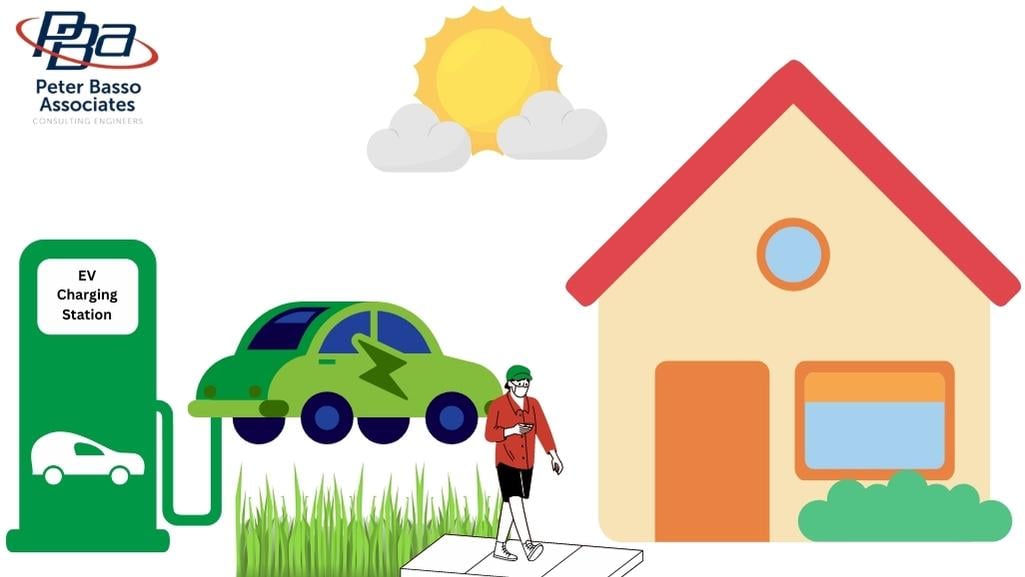-1.webp)
.jpg?width=800&height=451&name=EV%20Blog%20Datto%20(1).jpg)
Not all Electric Vehicle charging stations are created equally or to serve the same purpose. They all have their own benefits and costs. As such, it is important to understand what their differences are so that the right combination of chargers can be selected to meet your needs and budget.
What are my charging options?
Under the Electric Vehicle Charging umbrella, there are two general categories: AC (alternating current) charging and DC (direct current) charging. These categories represent the type of current that is delivered to the vehicle.

The most common form of EV Charging is AC Charging, which utilizes the AC-to-DC rectifier within an Electric Vehicle to charge the battery and is divided into Level 1 and Level 2 charging. The AC connector is standard (SAE J1772) for all American vehicles, other than Tesla. However, Tesla vehicles come with a free Tesla-SAE J1772 adapter.
Level 1 charging requires vehicle plug-in to a standard 120V electrical outlet and adds about 3-5 miles of range per hour. It is often referred to as a “trickle” charge as it can take multiple hours, or even days, to fully charge an EV. Typically, Level 1 charging is only used in residential applications. According to the U.S. Department of Energy, "80 percent of EV charging happens at home."
.jpg?width=1025&height=577&name=EV%20Level%201%20(1).jpg)
Level 2 is a 208V or 240V single phase charger with a range of outputs from 16 amps through 80 amps (3.3 kilowatts through 19.2 kilowatts) which can add about 10-30 miles of range per hour. The material cost of a Level 2 charger can range from a few hundred to a few thousand dollars depending on which options are desired.
Depending on the size of the charger, most existing electrical systems can support a couple Level 2 chargers without adding much to the electric vehicle charging infrastructure of a building.
.jpg?width=1025&height=577&name=EV%20Blog%20AVTA%20(4).jpg)
However, if there is a desire to add large Level 2 chargers or multiple Level 2 chargers, additional panelboards may be required. In some cases, the electrical service to a building will need to be upgraded and in this instance, DC Fast Charging options become a viable option to consider for facility owners.
How much to go How fast?
DC Charging uses an external AC-to-DC rectifier and directly charges an EV battery. DC Fast Charging (sometimes marketed as Level 3 or Level 4 charging)has a few distinctions. The rectifier is not confined to the physical footprint of an EV, it can be larger and in turn, allow for much faster charging speeds.
DC Fast Chargers utilize 480V three phase power and can range from 30 kilowatts to 360 kilowatts (10-120 times the average household electricity usage), adding between 90-1000 miles of range per hour. While the speeds seem very appealing, it comes at a price.
.jpg?width=1025&height=578&name=EV%20Blog%20DC%20money%20(1).jpg)
The material costs of a DC Fast Charger can range from tens of thousands to hundreds of thousands of dollars. In addition to this cost, most existing electrical systems cannot support DC Fast Chargers without substantial upgrades. Not only are the material costs for DC Fast Chargers priced too steep for EV owners to have for residential use, but it is basically impossible as most residences cannot get the voltage or service size required for the application.
This provides an opportunity for facility owners that are willing to invest in fast charging options that are attractive to EV owners. The prospect of charging up while conveniently shopping or managing long wait times to eat at your favorite restaurant is a great way to market your facility as a destination for EV owners.
What assistance programs are available?
The U.S. Department of Energy and the Vehicle Technologies Office (VTO) are partnering with Clean Cities coalitions around the country to improve batteries and electric drive systems. With the support of these VTO backed initiatives, researchers have access to simulation and modeling software tools that create virtual vehicles based on data collected from vehicles on the road and in the laboratory through the Advanced Vehicle Testing Activity (AVTA).
Let PBA be your EV Charging Partner
Peter Basso Associates has experience on multiple projects with design of Level 2 and DCFC EVSE as part of new construction and renovation work. We will walk you through options that fit your needs. In addition to our experience with EVSE equipment, we are power system specialists and can help you understand the full impact of implementing a EVSE installation.
These Stories on Electrical Engineering